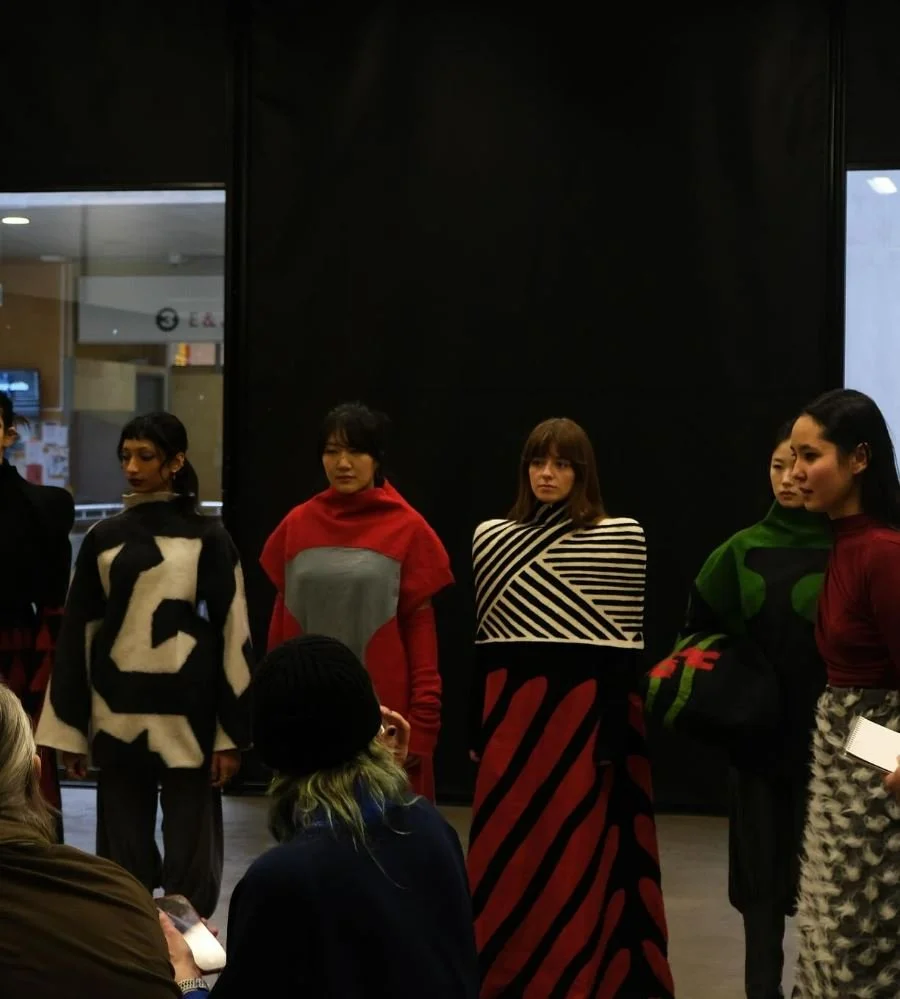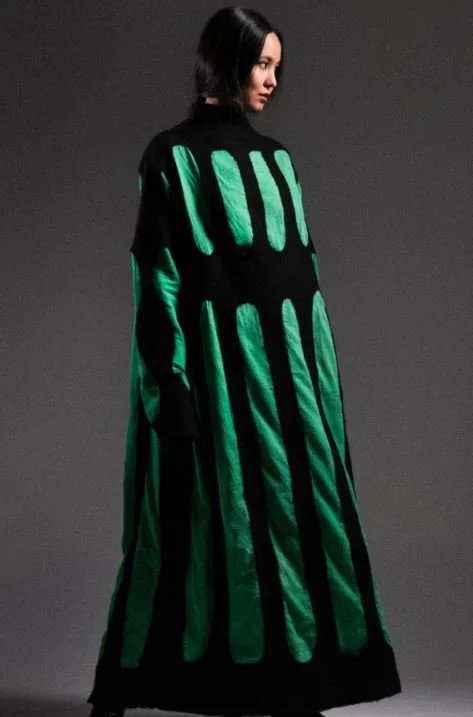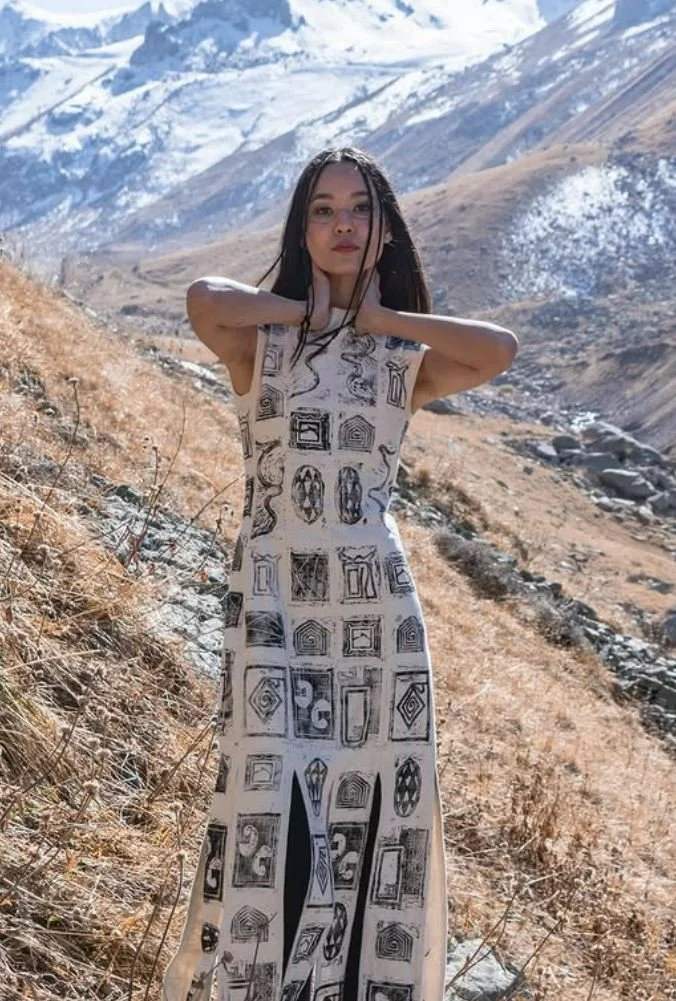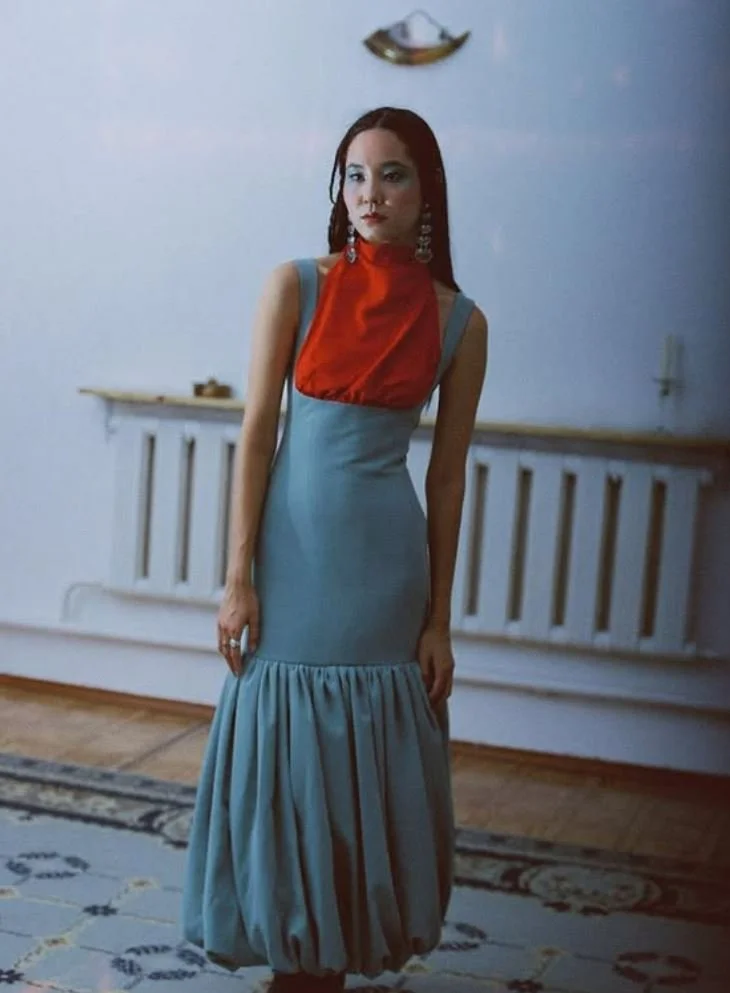Jamilya Kuanysheva
A few weeks ago I sat in my garden to have a phone call with recent Central Saint Martin’s graduate Jamilya Kuanysheva, to talk about her journey into becoming a fashion designer, and her recent graduate collection. It was a warm spring day in London, the sky was young, and there was an air of change and optimism. A very fitting environment for a phone call with a designer at the start of her career.
Jamilya Kuanysheva is only 26 years-old, yet she has already moved from Kazakhstan to London at the age of 16, gained a BA at London College of Fashion (LCF), modelled in London Fashion Week (LFW), graduated with a Master’s in Fashion at one of the world’s most renowned fashion schools, Central Saint Martin’s (CSM), and now is in the process of making her own label.
Her recent graduate collection alludes to different memories about the designers upbringing in Kazakhstan, and showcases her ability to incorporate harsh geometric patterns into wool-felt garments, that flatter a woman’s silhouette whilst simultaneously telling a story of rigidity and stubbornness.
Kuanysheva tells me that the inspiration behind her designs comes from her upbringing in Kazakhstan: “It was inspired by my home town Almaty, which was built during the Soviet Union, so it has very modernistic and brutalist architecture. Before that era our traditional culture is that we were nomads and very tribal, and our traditional craft was wool-felt, so I definitely wanted to give the wool-felting craft a new and contemporary vision, but I also wanted it to fit with this modernism of my home town, where all the decorations of the buildings are graphical shapes, minimalistic and bold architecture. For me it is like two histories of my country that I wanted to bring together.”
Kazakhstan was part of the Soviet Union from the 1930s up until 1991, and the brutalist architecture built during this time remains throughout the country, especially in Almaty where Kuanysheva is from. A famous piece of Soviet Union architecture is the Wedding Palace of Almaty built in 1971. If you Google it, you will immediately understand what brutalist architecture is. Monochromatic, simple shapes with straight edges and symmetrical designs, motifs seen throughout the collection. Kuanysheva's graduate collection achieves one of the most moving purposes of clothing, it tells a story whilst remaining wearable. But Kuanysheva does not just tell an on-the-nose story about where she is from, she also incorporates varying aspects of her life into effortlessly emotive clothing that marries two different eras of a culture-rich country.
As Kuanysheva mentioned, prior to the Soviet Union era, Kazakh natives were descendants of nomads. Therefore, the countries traditional clothing consists of practical outerwear such as loose-fitting tunics and trousers, coats, cloaks, gloves and hats all made from materials such as leather, wool, fur and felt. Traditionally, the process of creating felt, known as Kiyzu Basu in Kazakhstan, was a long and labour-intensive process. The material would be made from sheep’s wool, which would be washed and then laid out to dry on a matt of dried grass called a shyi in layers to achieve the desired thickness. It would then be rolled into felt.
The 26 year-olds garments are made from wool-felt, giving the clothing a stiff movement as the fabric is nonwoven, but instead made by condensing and matting wool fibres together. Kuanysheva even tells me that some of the pieces have no seams: “Some garments are fully wool felted, so there are no seams which was also a narrative that I wanted to explore. There is a zip so you can actually get into the garment, but there are no side seams.”
Modernising the felting process, Kuanysheva also incorporated cotton into some of the garments, by felting woollen patterns into cotton fabric, making one new fabric.
Image Credit: @master.it.london
A standout piece from the graduate collection is the loose fitting wool-felt A-line dress with green geometric detailing (above). To me the dress is the blurb of the collection; it summaries what the purpose of the collection is. The dress screams both traditional nomad clothing with brutalist architecture, and marries them perfectly to create a strong yet fluid look. The material adds to the story, not only because of its historical use, but also because of its movement. The wool-felt is more sturdy than materials such as silk or cotton that would normally be used for a dress like this, and it gives the dress structure. You can see in the picture that the garment moves away from the body, narrating the harshness of soviet-era life and architecture, as well as the practicality of clothing needed for nomad lifestyle.
Despite her incredible talent, Kuanysheva was not brought up in a household that worked in fashion or the arts, but her mum did expose her to fashion from an early age: “my mum was always dressed well and we would often have fashion TV on, and lots of magazines, so from my childhood I was exposed to it and I always enjoyed it.”
Image Credit: @askrov_
Above is Kuanysheva’s hand-printed dress, captured in the dramatic mountainous landscape of Almaty. The white, sleeveless panel dress shows just how skilled Kuanysheva is; not only can she tailor clothes to fit seamlessly (sometimes literally) but she can also hand-draw incredibly detailed designs which are unique and thought-provoking.
“My city is in the mountains, and I always go to the mountains, they give me the spirit of freedom and connection with my nomadic roots, which are a bit lost in our contemporary culture. Some of the prints on the dress are inspired by mountains. Mountains are very graphical in a way, the sharp angles and lines, and I really like that.”
When scrolling through Kuanysheva’s Instagram (@njamilya) a dress that stood out to me as completely different to the rest of the young designers creations was a light blue shift dress with gathered fabric below the knee creating a mermaid shape, and a red neck and chest panel (below). The dress is a colour and shape anomaly for Kuanysheva, yet it still feels like her.
Image Credit: @sa._.ti
What I found especially inspirational about my phone call with Kuanysheva was her true love for details and meaning in clothing, not just the commercial suitability of designs. Alongside creating her designs she has also done modelling, but not for the money or the fame, but instead for her love of design: “I know for some models it’s for money. I like being exposed to different designers, and I can talk to them in person and I can see the progression of the clothes. It showed me how much can change in the process because I was doing a lot of fittings, and then when I would see the end product I would remember how it was in the beginning and it gave me perspective on how progression works in design. With big brands as well it showed me that there is a huge team behind it, and they take details very seriously. Before I thought that it didn’t really matter, but now I know that 1millimeter can make a difference. I find it most fun to work with emerging designers because they’re young and they usually put much more deep ideas into their collections, whereas big brands sometimes go with what will sell.”
Kuanysheva tells me that the most inspiring designer to model for was her friend Pauline Dujancourt, when she modelled for Dujancourd’s graduate collection at CSM: “ I saw her collection at the very beginning and then I modelled for her graduate show, and now she is doing so well incredibly quickly. Last year she was a finalist at LVMH prize, and because I know her whole story I am very happy that she has grown so quickly. She is such a hard worker. She puts all of her energy and time into it, it is nice to see a young and ambitious emerging designer. It gives me hope.”
In recent years we have seen an influx of emerging Kazakhstani designers coming onto the global fashion stage, and I am excited to see Jamilya Kuanysheva become part of this movement: “I want to do my own label. It is a lot of work and a lot of time; I just need to be patient and resilient.”




